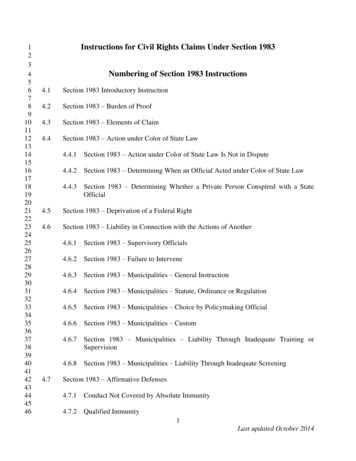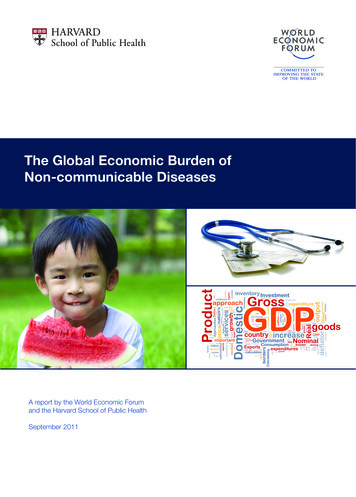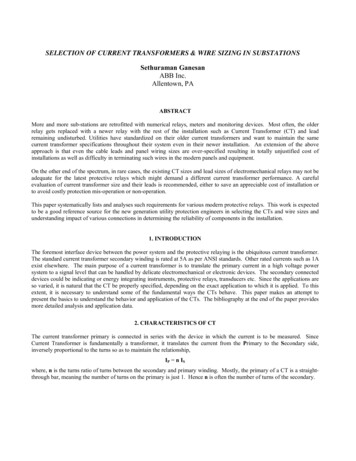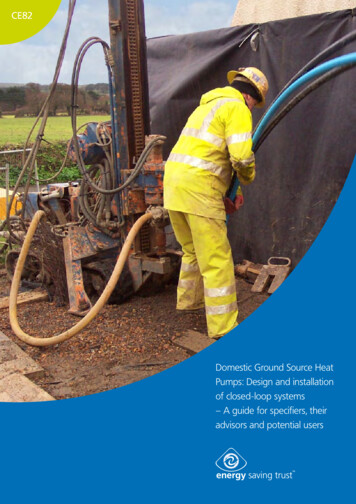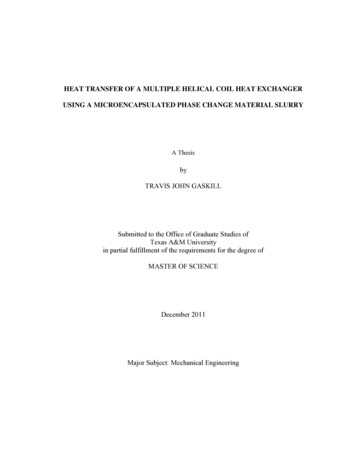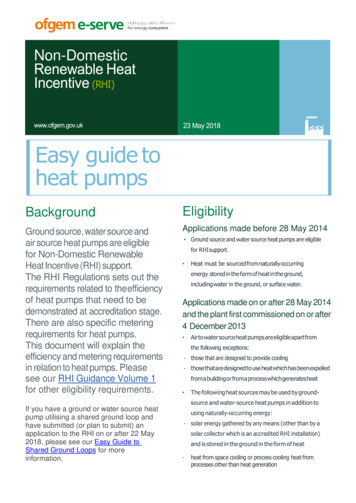
Transcription
Title: The burden of heat-related mortality attributable to recent human-induced climatechangeAuthor list:5A. M. Vicedo-Cabrera1-3*, N. Scovronick4, F. Sera3,5, D. Roye6,7, R. Schneider8,3,9,10, A.Tobias11,12, C. Astrom13, Y. Guo14, Y. Honda15, D. M. Hondula16, R. Abrutzky17, S. Tong18-21, M.de Sousa Zanotti Stagliorio Coelho22, P. H. Nascimento Saldiva22, E. Lavigne23,24, P. MatusCorrea25, N. Valdes Ortega25, H. Kan26, S. Osorio27, J. Kysely28,29, A. Urban28,29, H. Orru30, E.Indermitte30, J. J. K. Jaakkola31,32, N. Ryti31, M. Pascal33, A. Schneider34, K. Katsouyanni35,36, E.10Samoli35, F. Mayvaneh37, A. Entezari37, P. Goodman38, A. Zeka39, P. Michelozzi40, F.de'Donato40, M. Hashizume41, B. Alahmad42, M. Hurtado Diaz43, C. De La Cruz Valencia43, A.Overcenco44, D. Houthuijs45, C. Ameling45, S. Rao46, F. Di Ruscio46, G. Carrasco-Escobar47, X.Seposo48, S. Silva49, J. Madureira50,51, I. H. Holobaca52, S. Fratianni53, F. Acquaotta53, H. Kim54,W. Lee54, C. Iniguez55,7, B. Forsberg13, MS. Ragettli56,57, Y. L. L. Guo58,59, B. Y. Chen59, S. Li14,15B. Armstrong3,9, A. Aleman60, A. Zanobetti42, J. Schwartz42, T. N. Dang61 , D. V. Dung61, N.Gillett62, A. Haines3,8, M. Mengel63, V. Huber63,64, A. Gasparrini3,9,65*.Affiliations:201Institute of Social and Preventive Medicine, University of Bern, Bern, Switzerland2Oeschger Center for Climate Change Research, University of Bern, Bern, Switzerland.2
3 Department of Public Health, Environments and Society, London School of Hygiene &Tropical Medicine, London, United Kingdom.4 Gangarosa Department of Environmental Health. Rollins School of Public Health, EmoryUniversity, Atlanta, USA.55 Department of Statistics, Computer Science and Applications "G. Parenti", University ofFlorence, Florence, Italy6 Department of Geography, University of Santiago de Compostela, Santiago deCompostela, Spain.7 CIBER de Epidemiología y Salud Pública (CIBERESP), Spain108 Ф-Lab, European Space Agency (ESA-ESRIN), Frascati, Italy9 The Centre on Climate Change and Planetary Health, London School of Hygiene &Tropical Medicine, London, United Kingdom.10 European Centre for Medium-Range Weather Forecast (ECMWF), Reading, UK11 Institute of Environmental Assessment and Water Research, Spanish Council for15Scientific Research, Barcelona, Spain.12 School of Tropical Medicine and Global Health, Nagasaki University, Nagasaki, Japan13 Department of Public Health and Clinical Medicine, Umeå University, Umeå, Sweden.14 Department of Epidemiology and Preventive Medicine, School of Public Health andPreventive Medicine, Monash University, Melbourne, Australia.2015 Faculty of Health and Sport Sciences, University of Tsukuba, Tsukuba, Japan.16 School of Geographical Sciences and Urban Planning, Arizona State University, US.17 Universidad de Buenos Aires, Facultad de Ciencias Sociales, Instituto de InvestigacionesGino Germani, Buenos Aires, Argentina3
18 Shanghai Children’s Medical Center, Shanghai Jiao Tong University School of Medicine,Shanghai, China19 School of Public Health, Institute of Environment and Population Health, Anhui MedicalUniversity, Hefei, China520 School of Public Health and Social Work, Queensland University of Technology,Brisbane, Australia.21 Center for Global Health, School of Public Health, Nanjing Medical University, Nanjing,China22 Institute of Advanced Studies, University of São Paulo, São Paulo, Brazil1023 Air Health Science Division, Health Canada, Ottawa, Canada.24 School of Epidemiology and Public Health, University of Ottawa, Ottawa, Canada.25 Department of Public Health, Universidad de los Andes, Santiago, Chile26 School of Public Health, Fudan University, Shanghai, China.27 Department of Environmental Health, University of São Paulo, São Paulo, Brazil1528 Institute of Atmospheric Physics of the Czech Academy of Sciences, Prague, CzechRepublic29 Faculty of Environmental Sciences, Czech University of Life Sciences, Prague, CzechRepublic.30 Institute of Family Medicine and Public Health, University of Tartu, Tartu, Estonia.2031 Center for Environmental and Respiratory Health Research (CERH), University of Oulu,Oulu, Finland32 Finnish Meteorological Institute, Helsinki, Finland.4
33 Santé Publique France, Department of Environmental Health, French National PublicHealth Agency, Saint Maurice, France34 Institute of Epidemiology, Helmholtz Zentrum München – German Research Center forEnvironmental Health (GmbH), Neuherberg, Germany535 Department of Hygiene, Epidemiology and Medical Statistics, School of Medicine,National and Kapodistrian University of Athens, Greece36 MRC-PHE Centre for Environment and Health, Environmental Research Group, Schoolof Public Health, Imperial College London.37 Faculty of Geography and Environmental Sciences, Hakim Sabzevari University,10Sabzevar, Khorasan Razavi, Iran38 Technological University Dublin, Ireland39 Institute for Environment, Health and Societies, Brunel University London, London, UK.40 Department of Epidemiology, Lazio Regional Health Service, ASL ROMA 1, Rome,Italy.1541 Department of Global Health Policy, School of International Health, Graduate School ofMedicine, The University of Tokyo, Tokyo, Japan.42 Department of Environmental Health, Harvard T.H. Chan School of Public Health,Harvard University, Boston, MA, USA.43 Department of Environmental Health, National Institute of Public Health, Cuernavaca20Morelos, Mexico.44 Laboratory of Management in Science and Public Health, National Agency for PublicHealth of the Ministry of Health, Chisinau, Republic of Moldova.5
45 National Institute for Public Health and the Environment (RIVM), Centre forSustainability and Environmental Health, Bilthoven, Netherlands.46 Norwegian Institute of Public Health, Oslo, Norway.47 Institute of Tropical Medicine "Alexander von Humboldt", Universidad Peruana5Cayetano Heredia, Lima, Peru.48 Department of Environmental Engineering, Graduate School of Engineering, KyotoUniversity, Kyoto, Japan.49 Department of Epidemiology, Instituto Nacional de Saúde Dr Ricardo Jorge, Lisboa,Portugal.1050 Department of Enviromental Health, Instituto Nacional de Saúde Dr Ricardo Jorge,Porto, Portugal.51 EPIUnit – Instituto de Saúde Pública, Universidade do Porto, Porto, Portugal.52 Faculty of Geography, Babes-Bolay University, Romania.53 Department of Earth Sciences, University of Torino, Turin, Italy.1554 Graduate School of Public Health & Institute of Health and Environment, Seoul NationalUniversity, Seoul, Republic of Korea.55 Department of Statistics and Computational Research. Universitat de València, València,Spain.56 Swiss Tropical and Public Health Institute, Basel, Switzerland.2057 University of Basel, Basel, Switzerland.58 Environmental and Occupational Medicine, and Institute of Environmental andOccupational Health Sciences, National Taiwan University (NTU) and NTU Hospital,Taipei, Taiwan6
59 National Institute of Environmental Health Science, National Health Research Institutes,Zhunan, Taiwan60 Department of Preventive Medicine, School of Medicine, University of the Republic,Montevideo, Uruguay561 Department of Environmetal Health, Faculty of Public Health, University of Medicineand Pharmacy at Ho Chi Minh City, Ho Chi Minh City, VietNam62 Canadian Centre for Climate Modelling and Analysis, Environment and Climate ChangeCanada, Victoria, BC, Canada.63 Potsdam Institute for Climate Impact Research, Potsdam, Germany.1064 Department of Physical, Chemical and Natural Systems, Universidad Pablo de Olavide,Sevilla, Spain.65 Centre for Statistical Methodology, London School of Hygiene & Tropical Medicine,London, United Kingdom.15207
Abstract:Climate change affects human health, however, there have been no large-scale, systematic effortsto quantify the heat-related human health impacts that have already occurred due to climatechange. Here we use empirical data from 732 locations in 43 countries to estimate the mortality5burdens associated with the additional heat exposure that has resulted from recent humaninduced warming, during the period 1991-2018. Across all study countries, we find that 37.0%(range 20.5-76.3%) of heat-related deaths can be attributed to anthropogenic climate change, andthat increased mortality is evident on every continent. Burdens varied geographically, but wereon the order of dozens to hundreds of deaths per year in many locations. Our findings support the10urgent need for more ambitious mitigation and adaptation strategies to minimize the publichealth impacts of climate change.8
Main Text:Human activity has already changed the climate.1 The world is now an average of 1 C abovethe preindustrial era, though with substantial geographic heterogeneity; several high-populationregions have warmed by 2 C, while others have experienced relatively little change.1 An5immediate and direct impact of climate change is through human exposure to high outdoortemperatures, which is associated with morbidity and an increased risk of premature death(mortality).2–4 Although several studies have projected the impacts of heat exposure underdifferent potential future climate scenarios,5,6 there have been no systematic, large-scale studiesquantifying the heat-related health burdens attributable to climate change that has already10occurred.Detection and attribution studies evaluate the contribution of different factors, includinganthropogenic forcings, to observed changes in climate and weather.7,8 These studies are oftenconducted in the climate science disciplines and rarely take the additional step of estimatingassociated human health impacts.9–11 Here we take that step and quantify the contribution of15human-induced warming to the heat-related mortality burden in 732 locations from 43 countriesover the period 1991-2018. We do so by applying state-of-the-art methods from climate changeepidemiology to the largest database ever assembled on weather and health and the latest climatesimulations carried out in support of attribution and detection studies. To our knowledge, this isthe largest attribution study to date on the health impacts of climate change.20Attributing heat-related mortality to climate changeOur analysis proceeded in two steps. In the first step, we applied cutting-edge time-seriesregression techniques to observed temperature and mortality data from all 732 locations (Tables1, S1 and S2) to estimate location-specific exposure-response functions.12–15 These functions9
characterize the complex relationship between daily mean temperature and mortality from allcauses (or non-external causes) by simultaneously accounting for the non-linear and delayeddependencies typically found in this type of assessment.2 The functions were estimated using anovel extension of the widely-applied two-stage design that employs a mixed model approach to5properly account for the hierarchical structure of the data (see Methods).12–14 As described indetail in the Methods, first-stage model estimate associations for each location, which are thenpooled in a meta-analysis (the second stage). The observed temperature and mortality data werecollected through the Multi-Country Multi-City Collaborative Research Network (MCC), thelargest weather and health data consortium to date (https://mccstudy.lshtm.ac.uk).10Supplementary Table 1 provides a brief description of the observed MCC temperature andmortality series, including the data sources and level of aggregation (i.e. city, metropolitan areaor small region). The data used in the present study consisted of counts of daily mortality fromall causes or non-external causes only (ICD-9: 0-799; ICD-10: A00-R99), and daily meantemperature ( C). The analysis was limited to the warm season, defined as the four warmest15consecutive months in each location, to focus on heat-related mortality only (see SupplementaryTable 2 for the selected months in each location). The analysis included a total of 29,936,896deaths across all 732 locations from 43 countries in overlapping periods between 1991 and 2015(Table 1). The study countries vary widely in terms of local climate, ranging from averagewarm-season temperatures of 15 ºC in countries of North and Central Europe and Canada to20much hotter weather above 25 ºC in South Asia, the Middle East and parts of Central and SouthAmerica.In the second step, we used the estimated exposure-response functions to compute the heatrelated mortality burden between 1991 and 2018 for each location under two scenarios: a factual10
scenario consisting of simulations of historical climate (i.e. all climate forcings), and acounterfactual scenario where climate simulations are driven by natural forcings only, thusapproximating the climate that would have occurred in a world without human-induced oranthropogenic climate change.16 A more detailed description of the scenarios and how the5impacts were quantified is provided in the following paragraphs and the Methods section.The factual and counterfactual scenariosThe two scenarios (factual and counterfactual) were based on simulation runs from TheDetection and Attribution Model Intercomparison Project (DAMIP).17,18 DAMIP is thecomponent of the Coupled Model Intercomparison Project Phase 6 (CMIP6) that aims to assess10the individual contributions of different external factors, including anthropogenic forcings, onpast and future changes in global and regional climate. We used pairs of factual-counterfactualensemble runs of daily mean temperature between 1991 and 2018 from 10 general circulationmodels (ACCESS-ESM1-5, CanESM5, CESM2, FGOALS-g3, GFDL-ESM4, HadGEM3GC31-LL, IPSL-CM6A-LR, MIROC6, MRI-ESM2-0, NorESM2-LM - see Supplementary Table153 for further information) for which suitable data were available at the time of the analysis.Specifically, for the factual scenario we used CMIP6 historical simulations merged with SSP24.5 runs of each model which accounts for anthropogenic and natural forcings. Thecorresponding counterfactual consists of simulations of the historical climate driven with naturalforcings only (i.e. anthropogenic forcings are absent) derived from the hist-nat experiment.20Location-specific temperature series were extracted from the gridded products based on thecorresponding centroid, and bias-corrected following a method described elsewhere.19 Theburden attributable to recent human-induced climate change is defined as the difference in heatrelated mortality between the two scenarios.11
Figure 1 reports a summary description of the simulated warm-season mean temperatures in thefactual (accounting for natural and anthropogenic forcings) and counterfactual (accounting fornatural forcings only) scenarios. Across the 732 locations, the annual average temperature in thewarm season in the factual scenario increased from nearly 21.5ºC at the end of the twentieth5century to almost 23ºC in the 2010s, whereas in the counterfactual scenario, annual temperaturesremained relatively stable at around 21.5ºC (Figure 1A, model-specific time series plots areshown in Supplementary Data Figure 1). Similar patterns of warming over time can be observedacross countries, although with variable magnitude (Supplementary Data Figure 2). Warming isalso reflected in the overall temperature difference between scenarios over the study period10(1991-2018), with 0.8ºC increase on average and strong differences across regions of the world(Figure 1B, Supplementary Data Figure 3). For example, the country-specific averagetemperature increase ranged from 0.5ºC in Argentina to above 1ºC in Iran, Kuwait, somecountries in South and Central America and North of Europe (Figure 1B). Figure 1C shows thetemperature differences for each of the 732 study locations, with some of the largest effects seen15in Brazil and Western locations in South America, Southern Europe and Thailand.Location-specific temperature-mortality relationshipsExposure-response associations were estimated for all 732 locations. The curves for sixteenrepresentative locations – including at least one from each (inhabited) continent – are presentedin Figure 2. The functions represent the cumulative relative risk of death over a 10-day lag20period for each temperature value in the observed range. Prior research has demonstrated thatheat risks tend to occur quickly after exposure and then disappear within 10 days.20 Relative riskis a measure of association which represents the change in mortality risk at any giventemperature compared with a reference temperature, which in this case corresponds to the point12
of minimum mortality (i.e. the temperature value for which the risk of death is lowest), oftenreferred as the 'optimum'. In Chicago, for example, a 31 ºC day (corresponding to the 99thpercentile temperature) was associated with a 36% (95% confidence interval (CI): 28 to 47%)increase in mortality risk from all causes, whereas in Johannesburg the 99th percentile5temperature (24 ºC) was associated with a 9% (95% CI: 0.5 to 17%) increase and in Berlin (28ºC) a 57% (95% CI: 47 to 67%) increase.The displayed curves indicate potential geographical patterns in the heat-mortality relationshipacross and between regions, a finding particularly evident in Figure 3, which summarizes theexposure-response functions for all 732 locations, again as the relative risk of death at the 99th10percentile temperature versus the optimum. Heat-related mortality risks ranged from 0.97 to2.47, but with only 28 of the 732 locations below 1. Larger risks are observed in the Europeanregion, in particular the Western and Central area of the continent, while smaller estimates below1.5 were found in most locations in Asia and the Americas. All risks should be interpreted as anapproximation of the average heat-mortality association in each location across the study period.15Heat-mortality impacts attributed to climate changeThe estimated heat-related mortality burden by country for each scenario is derived by applyingthe location-specific exposure-response functions to the corresponding modelled locationspecific daily mean warm-season temperature series and average baseline mortality between1991 and 2018 (see Methods section for further details on the estimation of mortality burden).20Results are reported as heat-related mortality fractions estimated as the number of deathsattributed to heat (days above the optimum) divided by the total number of deaths during thewarm season in each location. The level of uncertainty of the impact estimates is expressed interms of 95% confidence intervals, which account for both the statistical uncertainty when13
estimating the exposure-response function and the variability in the temperature series acrossmodel-specific simulations (see Methods section for further details on the quantification ofuncertainty). Across all locations, heat-related mortality in the factual scenario amounted to anaverage of 1.56% (95% CI, 0.62 to 2.41) of all warm-season deaths (Figure 4A). The country5specific estimates ranged from below 1% (e.g. USA, Colombia, Sweden, Norway, UK, Japan,South Korea) to over 5% in countries of Southern Europe (also see Supplementary Table 4). Asexpected, there was less heat-related mortality in all countries under the counterfactual scenario,with an average estimate of 0.98% (95% CI, 0.26 to 1.80) across all locations.The difference between the factual and counterfactual scenarios is interpretable as the proportion10of total deaths during warm season attributable to human-induced climate change. The overallestimate that 0.58% (95% CI: 0.24 to 1.14) of all deaths are attributable to climate changetranslates to an average of 9,702 (95% CI, 4,005 to 19,135) deaths per warm season across the732 locations (see Supplementary Table 5 for location-specific estimates). Country-specificestimates (Figure 4B) show a clear North-South pattern within regions; human-induced climate15change attributable deaths are 1% of total deaths for countries in Northern sub-regions ofAmerica, Europe and Asia, while larger contributions were observed in Southern Europe,Southern and Western Asia and some countries in South-East Asia and South America. Thisgeographical gradient can be also observed in Supplementary Data Figure 4 that displays thelocation-specific estimates.20To further contextualize the results, Figure 4C displays the percent of heat-related mortality (asopposed to total mortality) that is attributable to human-induced climate change. The overallestimate is 37.0%, but this percentage varied widely across sub-regions and countries. Thelargest climate change-induced contributions (more than 50%) were in Southern and Western14
Asia (Iran and Kuwait), South-East Asia (Philippines and Thailand) and several countries inCentral and South America (see Supplementary Tables 4-5 and Supplementary Data Figure 5 forlocation-specific estimates).Taken together, our findings demonstrate that a substantial proportion of total and heat-related5deaths during our study period can be attributed to human-induced climate change, which is inline with the small number of existing attribution studies on this topic, mainly from Europe 10,21.Unlike those studies however, the wide and heterogeneous geographical scope of our datasetallowed us to assess spatial patterns in the estimated impacts and to identify areas that havealready been disproportionately affected. Impacts were evident in all of our study countries,10which included locations on every inhabited continent (Figure 4, Supplementary Data Figure 4and 5). As locations differ in size, Figure 5 displays the heat-related deaths attributable tohuman-induced climate change as a mortality rate, indicating a relatively heavy population-levelburden in Southern and Eastern Europe, where rates in several countries are above 6 per 100,000population over the 1991-2018 period compared to the study average of 2.2 per 100,000.15Some limitations of this study should be acknowledged. Despite the extensive spatial extent ofour study, we were not able to include locations in all world regions – for example large parts ofAfrica and South Asia – due to a lack of the empirical data needed to estimate the exposureresponse functions. For reference, our overall estimate that heat exposure from human-inducedclimate change is responsible for 0.6% of total deaths in warm season would translate to more20than a hundred thousand deaths per year if applied globally. However, we caution against thissort of crude extrapolation considering the variation we observed in location-specific estimatesof attributable fractions (Figures 4 and Supplementary DAtaFigure 4, Supplementary Table 5).Whether the excluded regions would have high or low heat-related mortality burdens is difficult15
to predict and may depend on factors including the level of warming, the built environment, andthe age structure and underlying health status of the population (amongst other factors).11,22,23Additionally, estimates should not necessarily be considered representative of country-specificaverage effects, as the study included a sample of locations which, in some cases, were restricted5to one or two cities (i.e. Finland, Iran). Another limitation is the use of a single, time-invariantexposure-response function in each location. This approach can be interpreted as anapproximation of the average effect across the study period in each location, but would notcapture the precise dynamics of any potential attenuation in heat-related risks, which has beenreported in some locations.24,2510We have conducted this large attribution study on the health impacts of climate change byapplying cutting-edge epidemiological modelling techniques to the most expansive database everassembled on weather and health (i.e. the MCC database) and the latest temperature simulationsdeveloped for climate change attribution and detection studies (i.e. DAMIP data). Themethodology allowed us to properly account for the uncertainty that arose from estimating the15exposure-response functions and the variability across climate models (see Supplementary DataFigure 6 for the model-specific estimates for heat-related mortality). We have demonstrated thathealth burdens from anthropogenic climate change are occurring, are geographically widespread,and are non-trivial; in many locations, the attributable mortality is already on the order of dozensto hundreds of deaths each year (Supplementary Table 5). This has occurred with average global20temperature increase of only 1 C, which is lower than even the strictest climate targets outlinedin the Paris Agreement (1.5-2 C), and a fraction of what may occur if emissions are leftunchecked.26 As a result, our findings provide further evidence of the potential benefits of16
adopting strong mitigation policies to reduce future warming and of enacting adaptationinterventions to protect populations from the adverse consequences of heat exposure.References:1. IPCC. Summary for Policymakers. In: Global Warming of 1.5 C. An IPCC Special Report5on the impacts of global warming of 1.5 C above pre-industrial levels and related globalgreenhouse gas emission pathways, in the context of strengthening the global response to thethreat of climate change, sustainable development, and efforts to eradicate poverty.(2018).2. Gasparrini, A. et al. Mortality risk attributable to high and low ambient temperature: a10multicountry observational study. Lancet Lond. Engl. 386, 369–375 (2015).3. Hsiang, S. et al. Estimating economic damage from climate change in the United States.Science 356, 1362–1369 (2017).4. Ye, X. et al. Ambient Temperature and Morbidity: A Review of Epidemiological Evidence.Environ. Health Perspect. 120, 19–28 (2012).155. IPCC. limate Change 2014: Synthesis Report. Contribution of Working Groups I, IIand III to the Fifth Assessment Report of the Intergovernmental Panel on ClimateChange. (2014).6. Ebi, K. L. et al. Health risks of warming of 1.5 C, 2 C, and higher, above pre-industrialtemperatures. Environ. Res. Lett. 13, 063007 (2018).207. Bindoff NL, Stott PA, Achuta Rao KM, et al. (2013). Detection and Attribution of ClimateChange: from Global to Regional. In: Climate Change 2013: The Physical Science Basis.Contribution of Working Group I to the Fifth Assessment Report of the Intergovernmental17
Panel on Climate Change. Cambridge University Press, Cambridge, United Kingdom andNew York, NY, USA.8. Cramer W, Yohe GW, Auffhammer M, et al. (2014). Detection and attribution of observedimpacts. In: Climate Change2014: Impacts, Adaptation, and Vulnerability. Part A: Global5and Sectoral Aspects Contribution of Working Group II to the Fifth Assessment Report ofthe Intergovernmental Panel on Climate Change. New York, NY: CambridgeUniversityPress,979–1037.9. Ebi, K. L., Ogden, N. H., Semenza, J. C. & Woodward, A. Detecting and Attributing HealthBurdens to Climate Change. Environ. Health Perspect. 125, 085004 (2017).1010. Mitchell, D. et al. Attributing human mortality during extreme heat waves to anthropogenicclimate change. Environ. Res. Lett. 11, 074006 (2016).11. Christidis, N., Mitchell, D. & Stott, P. A. Anthropogenic climate change and heat effects onhealth. Int. J. Climatol. 39, 4751–4768 (2019).12. Gasparrini, A. Modeling exposure-lag-response associations with distributed lag non-linear15models. Stat. Med. (2013) doi:10.1002/sim.5963.13. Gasparrini, A. & Armstrong, B. Reducing and meta-analysing estimates from distributed lagnon-linear models. BMC Med. Res. Methodol. 13, 1 (2013).14. Sera, F., Armstrong, B., Blangiardo, M. & Gasparrini, A. An extended mixed-effectsframework for meta-analysis. Stat. Med. 38, 5429–5444 (2019).2015. Vicedo-Cabrera, A. M., Sera, F. & Gasparrini, A. Hands-on Tutorial on a ModelingFramework for Projections of Climate Change Impacts on Health. Epidemiol. Camb. Mass30, 321–329 (2019).18
16. Gasparrini, A. & Leone, M. Attributable risk from distributed lag models. BMC Med. Res.Methodol. 14, 55 (2014).17. Gillett, N. P. et al. The Detection and Attribution Model Intercomparison Project (DAMIPv1.0) contribution to CMIP6. Geosci. Model Dev. 9, 3685–3697 (2016).518. Gillett, N. P. et al. Constraining human contributions to observed warming sincepreindustrial. Nat. Clim. Change. 11, 207-212 (2021).19. Hempel, S., Frieler, K., Warszawski, L., Schewe, J. & Piontek, F. A trend-preserving biascorrection – the ISI-MIP approach. Earth Syst Dynam 4, 219–236 (2013).20. Gasparrini, A. et al. Changes in Susceptibility to Heat During the Summer: A Multicountry10Analysis. Am. J. Epidemiol. 183, 1027–1036 (2016).21. Åström, D. O., Forsberg, B., Ebi, K. L. & Rocklöv, J. Attributing mortality from extremetemperatures to climate change in Stockholm, Sweden. Nat. Clim. Change 3, 1050–1054(2013).22. Basu, R. High ambient temperature and mortality: a review of epidemiologic studies from152001 to 2008. Environ. Health Glob. Access Sci. Source 8, 40 (2009).23. Benmarhnia, T., Deguen, S., Kaufman, J. S. & Smargiassi, A. Review Article: Vulnerabilityto Heat-related Mortality: A Systematic Review, Meta-analysis, and Meta-regressionAnalysis. Epidemiol. Camb. Mass 26, 781–793 (2015).24. Gasparrini, A. et al. Temporal Variation in Heat-Mortality Associations: A Multicountry20Study. Environ. Health Perspect. 123, 1200–1207 (2015).25. Vicedo-Cabrera, A. M. et al. A multi-country analysis on potential adaptive mechanisms tocold and heat in a changing climate. Environ. Int. 111, 239–246 (2017).19
26. Rogelj, J. et al. Paris Agreement climate proposals need a boost to keep warming well below2 C. Nature 534, 631–639 (2016).5MethodsObserved temperature and mortality data: the MCC databaseWe extracted observed daily temperature and mortality data for the 732 locations from the Multi-CountryMulti-City (MCC) Collaborative Research Network database (http://mccstudy.lshtm.ac.uk/).Supplementary Table 1 provides information on data collection for each country, while descriptive10statistics for each location are reported in Supp
20 31 Center for Environmental and Respiratory Health Research (CERH), University of Oulu, Oulu, Finland 32 Finnish Meteorological Institute, Helsinki, Finland. . and Pharmacy at Ho Chi Minh City, Ho Chi Minh City, VietNam . Here we use empirical data from 732 locations in 43 countries to estimate the mortality





